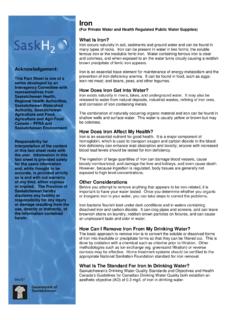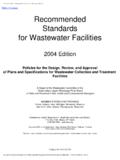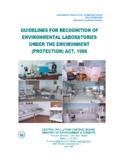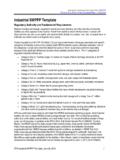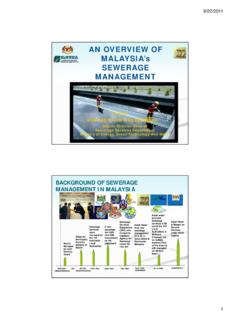Transcription of Waterworks Design Standard EPB 501 - SaskH 2 O
1 Waterworks Design Standard EPB 501 November 15, 2012 2 Foreword This document replaces A Guide to Waterworks Design published by Ministry of Environment on January 2008 . This Design Standard applies to all Waterworks described in The Waterworks and sewage Works Regulations and shall be used as a companion to the applicable Acts, Regulations and other provincial publications currently in use or as may be published from time to time. These publications include: The Environmental Management and Protection Act, 2010: The Waterworks and sewage Works Regulations; Guidelines for Canadian Drinking Water Quality Saskatchewan Drinking Water Quality standards and Objectives Government of Saskatchewan First Nation and M tis Consultation Policy Framework Municipal Drinking Water Quality Monitoring Guidelines Cartridge Filter Permitting Guidelines Chlorine Dioxide Waterworks System Assessment Questions and Answers Ozone Ammonia in Source Water System Depressurization Managing Wastes Generated by Water Treatment, Distribution, Maintenance.
2 Repair and Extension Guidelines for Chlorine Gas Use in Water and Wastewater Treatment Groundwater Under the Direct Influence of Surface Water Assessment Guideline Use of Chemicals in Drinking Water Treatment A Guide to Aquatic Nuisances and Their Control Terms of Reference Preparation Guide for Water and Wastewater work Studies Security at Water Treatment Plants Wellhead Protection Water Pipeline Design Guidelines Cross Connection Control and Backflow Prevention Program Guidelines The Design of a Waterworks shall: identify all items and factors that need be considered for the construction, operation and maintenance of a Waterworks ; and provide accepted practices suitable for Saskatchewan conditions. This Standard is not intended to be a detailed engineering manual.
3 Innovative or alternate approaches with demonstrated benefits are encouraged and need to be approved by the Water Security Agency and then utilized to protect both public health and the environment. Please forward inquiries concerning the standards and guidelines to: Environmental and Municipal Management Services Division Water Security Agency 420-2365 Albert Street Regina, Saskatchewan S4P 4K1 Phone: (306) 787-0726 Fax: (306) 787-0780 3 Table of Contents Page 1. Information Submissions for Approvals .. 5 Approval Requirements .. 5 Information on Application for Permit .. 5 General .. 5 Water Supply Changes .. 5 Water Treatment .. 6 Water Storage .. 6 Distribution .. 7 Heritage Resource Review .. 7 Consultation .. 7 Installation of New Waterworks Treatment Technology in Saskatchewan.
4 7 Approval by Regulatory History .. 7 Approval by Verification or Certification .. 7 Pilot Plants .. 8 Innovative Systems and Planning for Growth .. 8 Terms of Reference .. 8 2. Water Supply .. 9 General .. 9 Approvals .. 9 Characteristics .. 9 Multiple Supplies .. 9 Purchased Supplies .. 9 Surface Water .. 9 Capacities .. 9 Source Protection .. 10 Water Quality .. 10 Source Treatment .. 10 Intakes .. 10 Groundwater .. 11 Hydrogeological Characteristics .. 11 Source Protection .. 11 Water Quality .. 11 Other Design Considerations .. 11 Pumping Stations .. 11 Siting and Construction .. 11 Pumping .. 12 Controls and Appurtenances .. 12 Supply Pipelines .. 12 Capacity .. 12 Materials.
5 12 Location .. 12 Appurtenances .. 12 3. Treatment .. 13 General .. 13 Objectives .. 13 Selection of Water Treatment Processes .. 13 Capacities .. 14 Plant Siting .. 14 Building Construction .. 14 Building Services .. 14 Safety and Cross-Connection Control .. 15 Piping and Appurtenances .. 15 Operations and Maintenance .. 16 Personnel Facilities .. 16 Monitoring, Surveillance .. 16 Wastewater .. 16 4 Filter Backwash and other Process Waters .. 16 Surface Water and Groundwater under Surface 17 Processes .. 17 Chemical Application .. 18 Aeration .. 19 Coagulation Flocculation .. 19 Sedimentation Tanks (Clarifiers) .. 19 Filtration .. 20 Taste and Odour Control .. 22 Activated Carbon Adsorption.
6 23 Membrane Processes .. 23 Fluoridation .. 24 Disinfection .. 24 Instrumentations/Controls .. 26 Groundwater .. 27 Processes .. 27 Pre-Filtration Processes .. 27 Filtration .. 27 Manganese Greensand Filtration .. 27 Other Common Groundwater Treatment Processes .. 28 4. Treated Water Storage .. 28 General .. 28 Type of Storage .. 28 Location .. 29 Protection .. 29 Freezing .. 29 Safety .. 29 Capacities .. 29 Sizing .. 29 Fire Protection .. 29 Recommended Minimum Storage .. 29 Design Features .. 29 General .. 29 Materials .. 30 Protective Coatings and/or Cathodic Protection .. 30 Drains and Through-Piping .. 30 Drainage of Roof .. 30 Entrances .. 30 Vents .. 30 Cleaning/Disinfection.
7 30 Hydropneumatic (Pressure) Tanks .. 31 Pressure Tank Storage .. 31 Location .. 31 5. Distribution .. 31 General .. 31 Cross Connection Control .. 32 Pumping Facilities .. 32 General .. 32 Pumps .. 33 Distribution Systems .. 33 Materials .. 33 Layout and Placement .. 33 Sizes, Pressures .. 34 Fire Hydrants (Municipal Waterworks ).. 35 Valves, Appurtenances .. 35 Construction and Maintenance Practices .. 35 Water Loading Stations .. 36 Appendix 37 43 5 1. Information Submissions for Approvals Approval Requirements An approval to construct, extend or alter any Waterworks must be obtained from the Water Security Agency before starting construction of such works. The requirement for an approval to construct is seen in Section 24 of The Environmental Management and Protection Act, 2010.
8 Applications for approval are required to be made on prescribed forms. Typical examples of works requiring construction approvals include: water treatment facilities including surface water, groundwater and GUDI plants; water distribution systems and extensions at systems serving fewer than 5000 people; and water pumping stations; Applications for approvals are required to contain information prescribed in section Information shall be in a concise form and a logical order. Drawings and plans shall conform to good engineering practice. Previously submitted information need not be resubmitted unless it is affected by the construction, extension or alteration or updating is appropriate. Information on Application for Permit General When a person makes an application for a permit, he/she shall include in the application: engineering reports for new systems and major modifications; name(s) of owners and responsible party for operation and maintenance; designer or responsible engineer or engineering firm; proposed period of construction and anticipated operation date; cost estimates for the work including applicable local improvement or capital portions.
9 Where new water distribution piping or a new volume load on the water treatment plant is proposed, provide a statement that the water pumping, treatment and existing Waterworks are adequately sized to meet all requirements including meeting all required MAC quality limits OR provide a statement indicating how pumping, treatment and existing works will be upgraded or mitigated in a manner previously negotiated with and agreed to by the Water Security Agency; proposed security features at the works (refer to publication Security at Water Treatment Plants); and if applicable, application for permit shall include easement agreement containing the following information and provisions: a) the name of the person proposing to construct, extend, alter or operate the Waterworks that is the subject of the easement; b) the nature and extent of the construction, extension, alteration or operation of the Waterworks that is the subject of the easement; c) the name of the registered owner of the land on which the Waterworks that is the subject of the easement is to be constructed, extended, altered or operated and, if different, the name of the registered owner of the land affected by the Waterworks that is the subject of the easement; d) the legal description of the lands mentioned in clause (c); and e) a provision that: i.
10 Grants an easement by the registered owners of the lands affected by the Waterworks that is the subject of the easement; ii. conveys a right to use the land for the purposes and to the extent required to construct, alter, extend or operate the Waterworks that is the subject of the easement; and iii. states that the easement runs with the land and is binding on the present and subsequent registered owners of the lands affected by Waterworks that is the subject of the easement and their heirs, executors, administrators and assigns. Water Supply Changes An Alteration in water source is defined as a change away from the existing surface water class or groundwater class or GUDI source class; for example changing from a groundwater class to a surface water class source.






